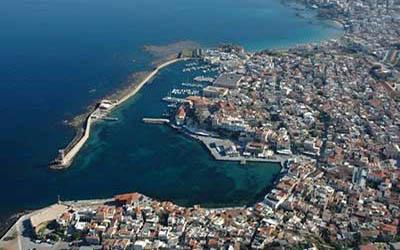
Chania
Chania, is a very attractive city, especially if you can catch it in spring, when the White Mountains’ snowcapped peaks seem to hover above the roofs. Although it is for the most part a modern city, you might never know it as a tourist. Surrounding the harbour is a wonderful jumble of Venetian streets that survived the wartime bombardments, while simply wandering the old town you will discover old city walls, Ottoman, Byzantine and Minoan ruins. Restoration and gentrification, consequences of the tourist boom, have made inroads of late, but it remains an atmospheric place.
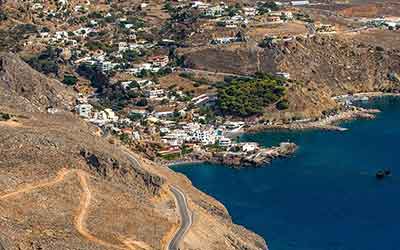
The southwest coast
The ancient capital of the Sfakiá region, Hóra Sfakíon, lies 70km south of Haniá, reached via a spectacular twisting asphalted road over the mountains. It’s the main terminus for gorge walkers, with a regular boat service west along the coast to Ayía Rouméli and Loutro, which are accessible only by foot or boat. Frangokastello, with its castle fortress and sandy beaches, lies a few kilometres east of Hóra Sfakíon, along the coastal road. Other main routes south over the mountains from Haniá are those to the small town of Paleóhora (from the north-coast highway at Tavronítis) and to the laidback seaside village of Soúyia (via Alikianós on the Omalós road). Crete’s western most quarter is one of its least visited, partly because there are no big sandy beaches to accommodate resort hotels, and partly because it’s so far from the great archeological sites. But for mountains, scattered coves and unexploited villages, it’s unrivalled.

Old Port
Like many places in Greece, the Old Venetian Harbor in Chania shows how diverse Greece’s history really is. On the island of Crete, the Venetians considered Crete, which was then referred to as the Kingdom of Candia, one of their holdings. As part of their influence, the island of Crete has many Venetian structures and fortresses. The Old Venetian Harbor is one of these places. Considered one of the main hubs of the island at the time, the harbor has an old fortress and a lighthouse that is perched at the end of the long stretch. Dating from the 14th century, the old harbour is ringed by a promenade lined with seafood eateries and cafés; it buzzes with visitors in summer, and is totally enchanting by night.

Old Town
One of the best things to do in Chania is wander through the maze of narrow, pedestrian-only streets in the historic old town. An architectural style jumps out at you around every corner. Shops lining the streets and stairways sell souvenirs, and cute restaurants and cafés are tucked into shady patios. The borders of the Old Town are the mostly destroyed old Venetian wall (and bulwarks) and this has been the cradle of all the civilizations which were developed in the area. The central part of the old town is named Kasteli and has been inhabited since Neolithic times. It is located on a small hill right next to the seafront and has always been the ideal place for a settlement due to its secure position, its location next to the harbour and its proximity to the fertile valley in the south. Nowadays it is a bit more quiet than the neighbouring areas of the west part of the district. The Splantzia quarter (next to the east part of Kasteli) is also largely untouched. The Topanas area has many narrow alleys and old buildings, some of which have been restored as hotels, restaurants, shops and bars. This makes it a popular place especially during the warm period (April–October). In the winter, it still remains a centre of activities (especially for nightlife).
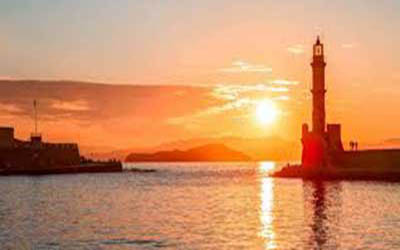
Chania Lighthouse
Walk the Seawall to the Lighthouse One of the best views of the old port and Chania's old town can be found by taking a pleasant stroll along the Venetian seawall to the 19th-century lighthouse. The walk takes about 15 minutes one way, at a leisurely pace. This walk will also take you by some of the main sights in the old port, including the Yiali Tzami mosque and the Venetian arsenals.
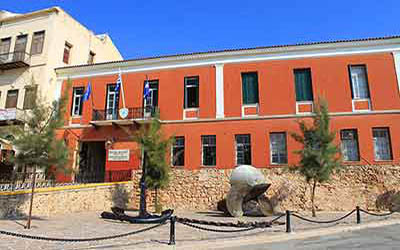
Maritime Museum of Crete
This museum, at the tip of land across the channel from the lighthouse, traces Crete's centuries-old relationship with the sea, from the Minoans, through the Byzantine, Venetian, and Turkish periods, to arrive at the German invasion of the island during WWII. Spread over two floors, the collection includes video presentations, amazing models of ships, paintings, photos, and nautical equipment. You'll find it at the western corner of the old harbour in a lovely red building constructed by the Venetians and used as a prison. Note that at the Moro dock, in one of the Venetian arsenals east of the old harbour, you can also see the Minoa, a reconstructed 15th-century-BC Minoan ship. Address: Fort Firkas, Akti Koundourioti, 73136 Chania, Crete Official site: http://mar-mus-crete.gr/en/the-museum/
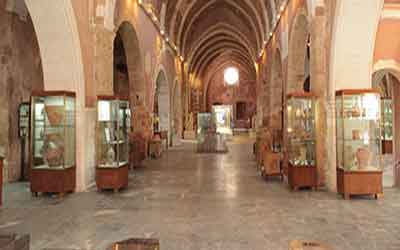
Archaeological Museum of Chania
Chania's history dates back millennia to somewhere around 2200 BC, when the Minoans founded the ancient city-state of Kydonia on this same spot. Housed in the Gothic Church of San Francesco, a light and airy vaulted space (built by the Venetians and later used as a mosque by Turks), this museum holds archeological finds from western Crete dating from Neolithic times through to the Roman era.
The museum displays a wealth of Minoan ceramics, painted burial urns, gold jewelry, and clay tablets with inscriptions. Other notable exhibits include peculiar clay figurines of bird-faced women, votive ceramic bulls, a third-century Roman mosaic floor, and an impressive marble bust of Roman Emperor Hadrian.
Address: 21 Halidon Street, 73136 Chania, Crete
Official site: http://chaniamuseum.culture.gr/en/
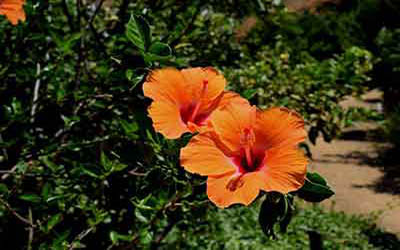
Botanic Park & Gardens of Crete
With its warm, sunny climate and rich, fertile soils, Crete grows olives and grapes, and even farms tropical fruits, such as avocados and bananas. In this carefully tended park, at the foot of the White Mountains, a meandering two-kilometer path takes you through a garden planted with exotic flowers and fruit trees from all over the world, with everything clearly labeled. Shady spots with benches amid fragrant herbs such as sage, mint, and thyme offer places to relax and escape the sun. You can borrow a walking stick and hat at the entrance, and a free bottle of water is included with the ticket. There is also a café-restaurant serving traditional Cretan dishes prepared from the park's own seasonal products. The Botanic Park is accessible by bus from Chania and is a must for plant lovers. Address: Fournes, 18 kilometers southwest of Chania, Crete Official site: www.botanical-park.com

The Monasteries of Akrotiri Peninsula
Agia Triada Monastery or the Monastery of Agia Triada Tsangarolon is a Greek Orthodox monastery in the Akrotiri peninsula in the Chania regional unit, Crete, Greece. It also contains a museum. The monastery, whose name means "Holy Trinity", was built in the 17th century by two brothers of the Venetian Zangaroli family on the site of a pre-existing church.The monks produce and sell wine and olive oil on the premises. A short drive away stands the fortress-like Gouverneto, founded in 1537. Even if the monastery is closed, the location is beautiful. From here, a footpath leads past Arkoudiospilia (Bear Cave), down 140 steps to Katholiko, an abandoned sixth-century monastery, built into a cliff face. After seeing the monasteries, head for Stavros Bay for a swim at the sandy beach where Anthony Quinn danced in the 1964 film Zorba the Greek.
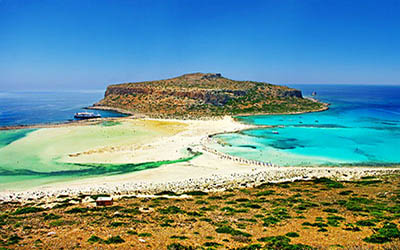
Balos Lagoon
On the northwest coast of Cape Gramvousa, in a bay formed between the lesser capes of Tigani and Vouha, lies the sea-lagoon of Balos. A quiet beach, opposite the two Gramvousa islands (Wild and Tame), it features warm, turquoise waters and white sand. The sand is actually partly composed of minutely crushed sea-shells, which impart a pinkish hue to it. The water immediately off shore is shallow, but deepens elsewhere. This is clearly one of the highlights of any trip around Crete. It is a very popular spot for a good reason. The area is wild with mountains dropping into the sea, islands creating a bay and a shallow lagoon to enjoy it all. The sand is white and pink, the water is turquoise, the rock dark the sky is blue... this is a beautiful rainbow of colors! The easiest option to get there is to take the boat from Kissamos, it first stops at Gramvousa island and then takes you to the Lagoon. Location: Kissamos, Chania, Crete.
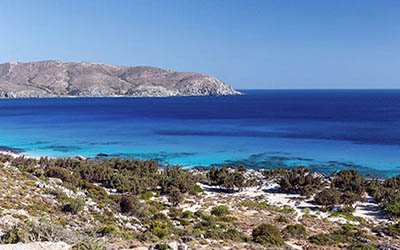
Elafonissi & Kedrodasos
Elafonissi beach is one of the most emblematic of the island, and is featured on countless postcards. It can be found 80 km from Chania. Elafonissi is a small island, connected to the Cretan mainland by a shallow crossing of several hundred meters. The whole area, which is part of the NATURA 2000 programme, is characterized by pale sands, shallow and crystal-clear waters turquoise in colour, and small pink patches made up from crushed sea-shells.South of Elafonissi is another area of wild and remarkable beauty: Kedrodasos, also part of the NATURA 2000. Access can be by car (up to a certain point) or on foot following the E4 walking-route from the beach of Elafonissi itself. Dunes of white sand and ancient cedars cover the vicinity. The main beach is sandy and also boasts crystal-clear turquoise waters. Along the coastal path from Elafonissi to Kedrodasos there are small deserted coves. Unlike Elafonisi, Kedrodasos is absolutely unspoilt and because of its isolation nudists like to come here. Location: Kissamos, Chania, Crete.

Day Trip to Hike the Samaria Gorge
The Samariá Gorge is a National Park of Greece since 1962 on the island of Crete – a major tourist attraction of the island – and a World's Biosphere Reserve.The gorge is in southwest Crete in the regional unit of Chania. It was created by a small river running between the White Mountains (Lefká Óri) and Mt. Volakias. There are a number of other gorges in the White Mountains. While some say that the gorge is 18 km long, this distance refers to the distance between the settlement of Omalos on the northern side of the plateau and the village of Agia Roumeli. In fact, the gorge is 16 km long, starting at an altitude of 1,250 m at the northern entrance, and ending at the shores of the Libyan Sea in Agia Roumeli. The walk through Samaria National Park is 13 km long, but one has to walk another two kilometers to Agia Roumeli from the park exit, making the hike 15 km long. The most famous part of the gorge is the stretch known as the Gates (or, albeit incorrectly, as "Iron Gates"), where the sides of the gorge close in to a width of only four meters and soar up to a height of almost 300 meters (980 feet). The gorge became a national park in 1962, particularly as a refuge for the rare kri-kri (Cretan goat), which is largely restricted to the park and an island just off the shore of Agia Marina. There are several other endemic species in the gorge and surrounding area, as well as many other species of flowers and birds. The village of Samariá lies just inside the gorge. It was finally abandoned by the last remaining inhabitants in 1962 to make way for the park. The village and the gorge take their names from the village's ancient church, Óssia María. A must for visitors to Crete is to complete the walk down the gorge from the Omalos plateau to Agia Roumeli on the Libyan Sea, at which point tourists sail to the nearby village of Sougia or Hora Sfakion, where they could spend a night there, or they could catch a coach back to Chania. The walk takes five to seven hours and can be strenuous, especially at the peak of summer. Local tourist operators provide organized tours to the Gorge. These include bus transportation from one's hotel to the entrance (near Omalos village), and a bus connection that will be waiting for hikers after they disembark the ferry in Sougia or Sfakia (Chora Sfakion). If you are on your own, you can make a one-day round trip from Chania (see below) or from Sougia or Paleochora.
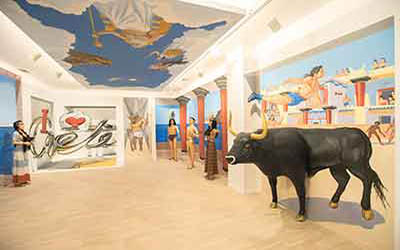
Minoan's World 3D Museum
This is the perfect place for families with children to spend part of an afternoon. A unique and interesting introduction to the ancient history of Greece is provided in a manner that everyone can enjoy. Interesting displays make for fun photo opportunities in the first part of the museum. Following that, you'll be treated to a 9D movie, where all your senses will be engaged. This is the perfect place to escape the midday heat or the rare rainy day and learn a bit along the way. Official site: https://minoansworld.com/english
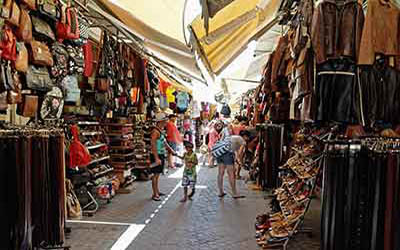
Municipal Market of Chania
The Municipal Market of Chania is commonly known as the "Agora". It was built between 1909 and 1913 and modelled on the covered market of Marseilles. It has a cruciform shape and space inside for a large number of shops. It was built on the site of a bastion of the Venetian fortification wall. Housed in a 4,000-square-meter structure built in 1911, you'll find sellers offering, vegetables, meats, and fish at the peak of its freshness. If you are on a self-catering vacation in or around Chania, this should be your first stop to stock up. It's interesting to note that a majority of the items are grown on Crete. The island's unique climate and topography allow for the cultivation of a wide variety of produce throughout the year.


